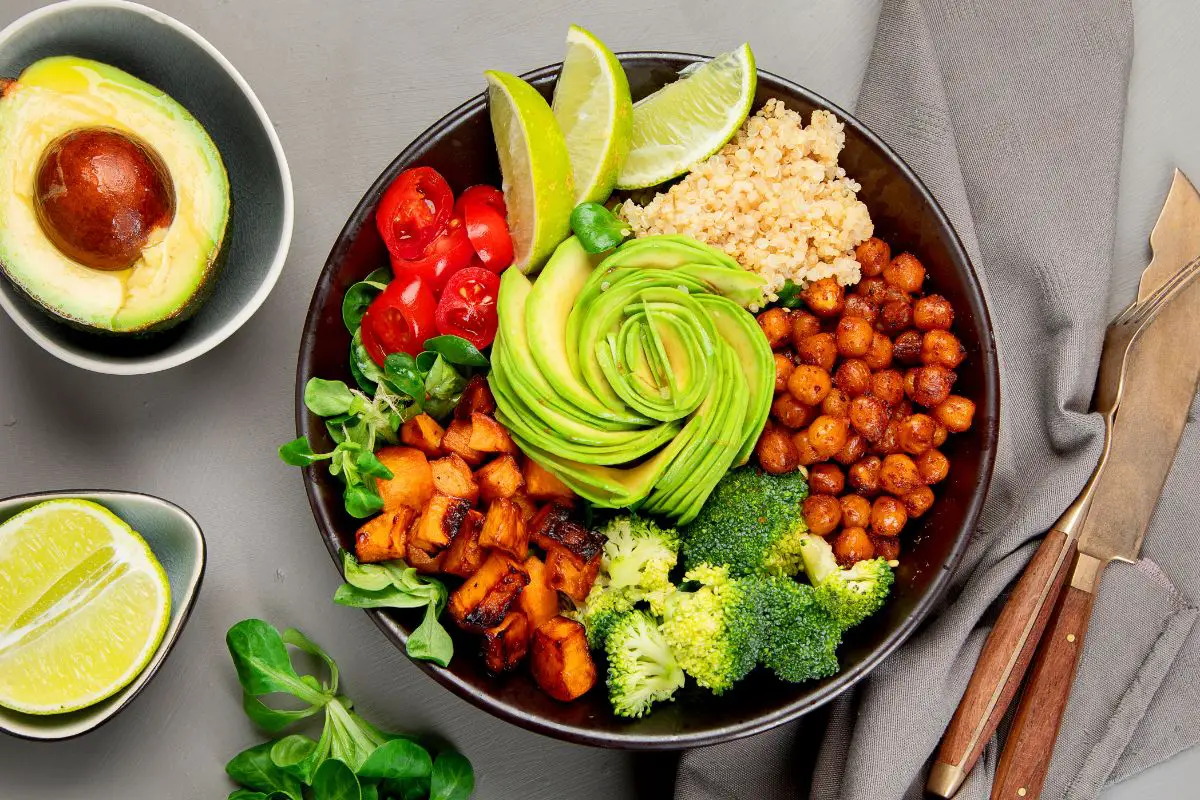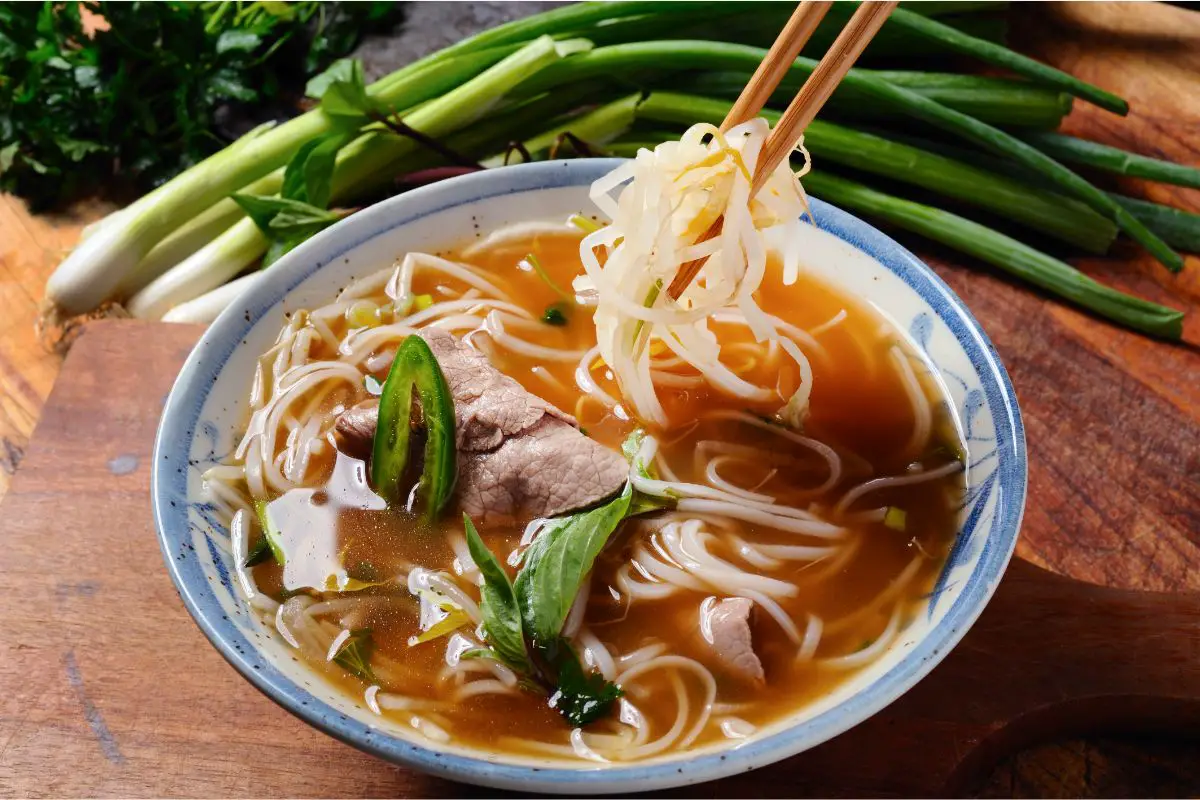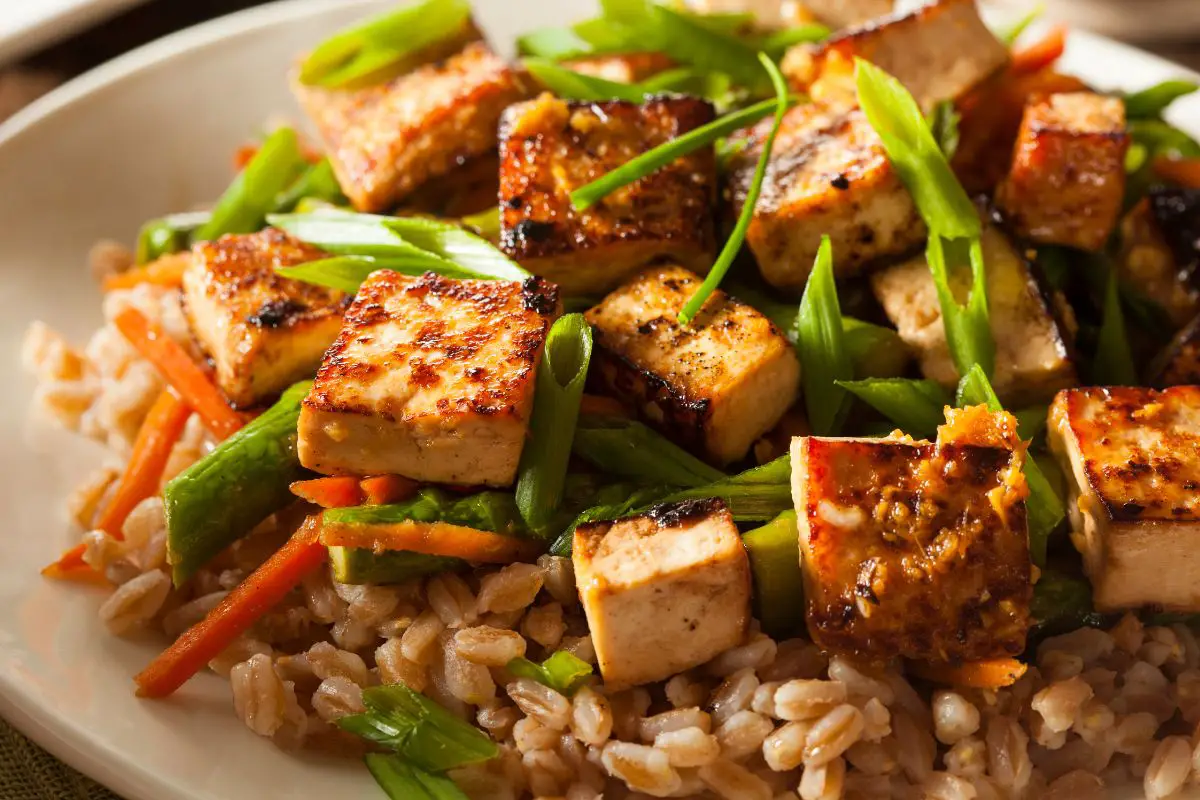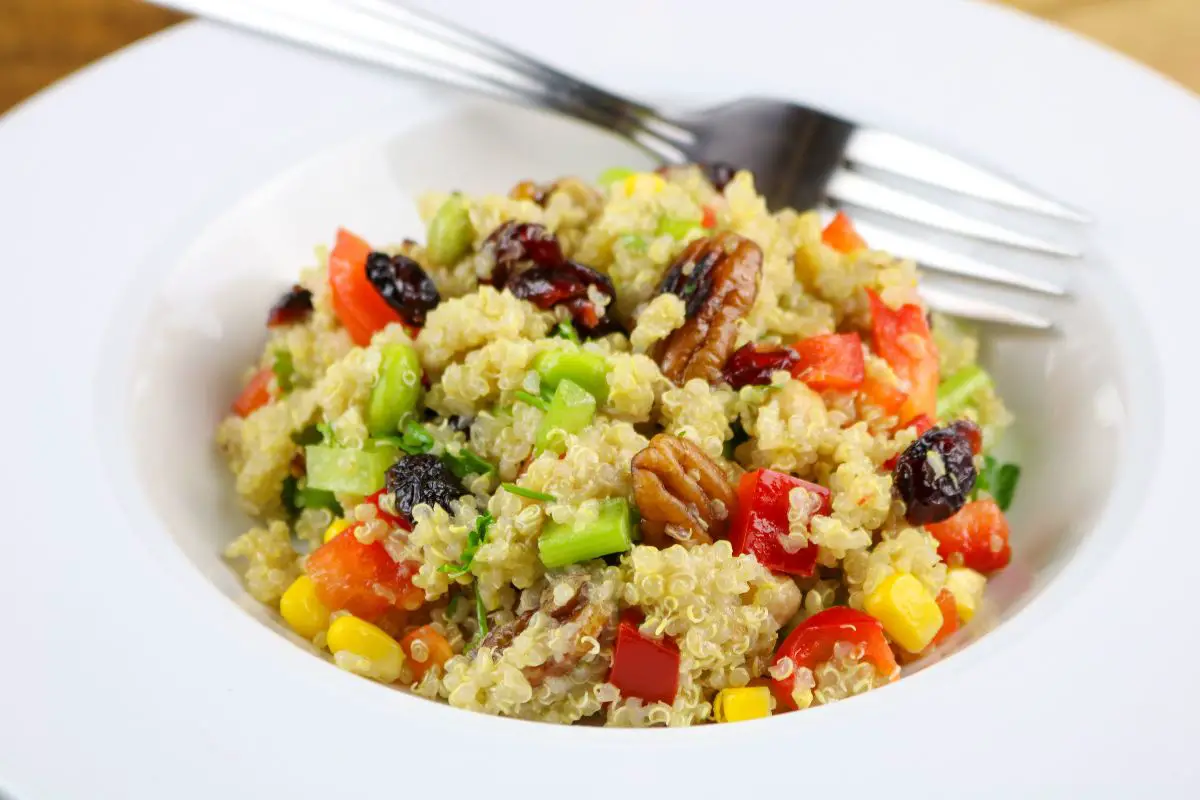If you’re looking for a quick that’s meat-free and easy to put together, you have to give this Vegetarian Mapo Tofu a try!

This dish is full of tasty Sichuan notes which are sure to turn you into a tofu fan. You’ll notice a nice blend of savory, salty flavors which dance on the tongue.
This delicacy is unlike other tofu dishes, as it swaps firm tofu blocks for soft ones.
The soft tofu contains more water, which makes each bite delicate and smooth. Its silky texture will easily absorb the scrumptious sauce ingredients, which is great if you prefer more flavorful dishes.
Mapo Tofu is usually made with minced beef, but this version leaves the meat out to make it vegan and vegetarian-friendly.
You’ll learn how to make this recipe in the post, including more information about tofu and its possible health benefits.
Tofu: The Basics
Tofu was first made in China, but it is now enjoyed all over the world. Each block is made from condensed soy milk which has been condensed down into solid pieces, similar to how cheese is produced.
One of the ingredients is nigari, a clotting agent which is a byproduct of extracting salt from seawater. This helps the tofu become solid and maintain its shape.
Once the soy curds start separating, they are filtered and condensed into a firm block. If the curds are pressed longer, the block will contain less water, and vice versa.
Tofu has a noticeable taste and consistency. It has a creamy texture that resembles cream cheese, but it has a gentle flavor.
Tofu can be eaten right out of its packaging, but it’s best to cook it, as this will improve its flavor and texture.
Tofu has an advantage, as it easily absorbs the notes of any ingredients used in a recipe. You can purchase many different kinds of tofu, such as extra firm, firm, medium, and silken.
Silken and soft tofu blocks will contain more water, while firmer varieties contain less.
It’s best to use soft tofu blocks to make Mapo Tofu, as this will ensure the dish has a creamy and velvety feel.
Benefits Of Tofu
Here are some of the nutritious benefits of tofu.
High In Protein
Tofu is an amazing source of plant-based protein. The ingredient is also known as a complete protein, which means all of the essential amino acids are present in each block.
This is noteworthy as a lot of animal food sources are complete proteins, but the same can’t be said for plant-based foods.
If you are a vegan or vegetarian, including tofu in your diet can help you reach your daily protein requirements.
High In Iron
Tofu has a decent amount of iron, an important mineral that supports the immune system and allows the body to derive energy from nutrients.
Iron-rich foods are particularly important for vegans and vegetarians, particularly non-meat-eating athletes. These individuals have a greater risk of low iron levels compared to athletes who eat meat.
Despite its iron levels, bear in mind that the body doesn’t absorb the iron within tofu, known as nonheme iron, as easily as iron from animal food sources.
Eating foods rich in vitamin C can help your system soak up plant-based iron better, like red bell peppers or strawberries.
Packed With Calcium
Tofu blocks that are produced with calcium sulfate are quite high in calcium. Calcium is another important mineral that is necessary to maintain bone health.
The calcium within tofu will differ across each brand, but a three-ounce serving generally contains roughly 1,000 to 1,300 mg of calcium. This is around 10% of your daily calcium requirements, so dairy-free individuals may want to take note.
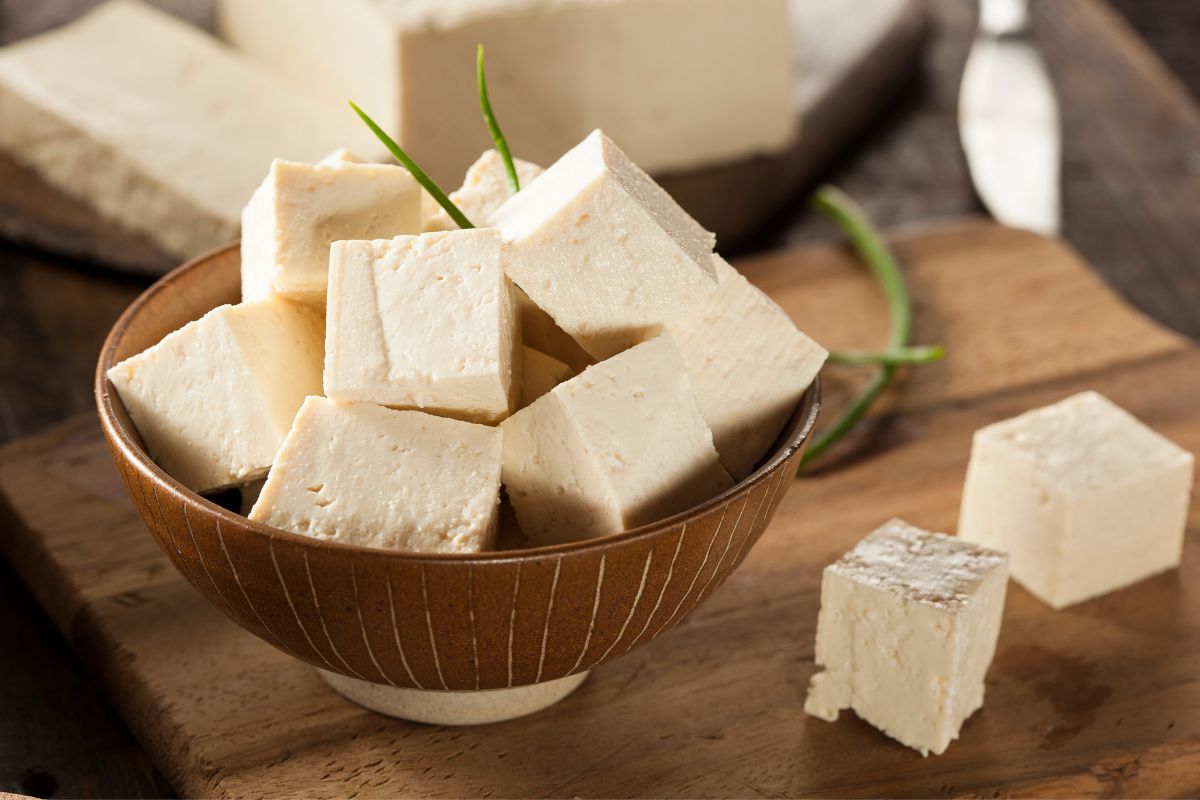
Disadvantages Of Tofu
Tofu may have its health benefits, but it does carry some drawbacks too.
Not That Rich In Fiber
Tofu is made from soybeans, an ingredient that is very rich in fiber. Just half a cup contains roughly five grams of fiber, so it’s easy to believe that tofu would be fiber-rich too.
This isn’t the case, however, as soybeans lose most of their fiber as they’re refined to make tofu.
You can ensure that you get enough fiber when eating tofu dishes by consuming fiber-rich foods alongside the dish, like quinoa, avocados, or sweet potatoes.
Soy Isoflavones
Isoflavones aren’t typically included on nutrition labels, but they are present in edamame, tofu, and various soy items. Isoflavones are potent phytochemicals that can have impressive antioxidant qualities.
Research has shown that they may be connected with healthy skin and may even relieve menopausal symptoms.
In the past, isoflavones were believed to increase the likelihood of breast cancer, due to their effect on hormones. Now, however, recent research has proposed that this may not be true.
A study looked at Asian women and found that the participants who ate soy products earlier had a lower risk of breast cancer in the future. Despite these findings, more research is needed to look into soy and its effects.
It’s best to consume tofu in moderation, or limit your soy intake if you are at risk of breast tumors.
Heart Health
The ‘heart healthy’ label is often included on soy milk cartons and tofu packaging. It was previously believed that soy protein could reduce LDL cholesterol (the ‘bad’ cholesterol) levels, reducing the risk of heart disease as a result.
The FDA formally sanctioned this belief in 1999, which led to a lot of soy manufacturers printing heart-healthy labels on their products.
Seven years on, however, the ADA (American Heart Association) found that soy protein may not affect cholesterol levels as much as first believed.
After these findings, the FDA amended its stance and came up with a new rule. This meant that manufacturers would need to eliminate any health claims about cardiovascular disease and soy from their packaging.
Substituting red meat for tofu can be a great way to lower your saturated fat intake, but don’t assume that tofu can have a huge effect on your LDL levels.
How To Cook Vegetarian Mapo Tofu
Now that you know a little more about tofu, you can learn how to put this tasty dish together! Mapo Tofu is a Chinese dish that consists of a flavorful, spicy sauce and soft pieces of tofu.
An important ingredient in this recipe is Sichuan peppercorns. These aren’t really peppercorns, but they are seed husks taken from ash shrubs.
These peppercorns are interesting as they have a gentle numbing effect on the taste buds when they pass over the tongue.
The sauce in the Mapo Tofu is created from a blend of Sichuan peppercorns, doubanjiang (fermented chili bean paste), oil, broth, sugar, and soy sauce.
All of these ingredients are cooked together until they break down into a sauce. The result is a savory, spicy dish that tastes amazing next to the creamy tofu.
Vegetarian Mapo Tofu Ingredients
Here are the ingredients you’ll need to make this Chinese dish.
- Brown sugar: This helps neutralize the notes in the dish. You can use white sugar if brown isn’t available.
- Cornstarch: Works as a thickening agent to make the sauce less runny
- Doubanjiang: This is also called fermented chili bean paste. This is an ingredient that’s often used in Sichuan dishes. You can use spicy or non-spicy versions, depending on your preferences, but the spicy version will have a deeper red shade.
- Garlic: Use fresh garlic that’s been well chopped
- Ginger: Use fresh ginger to add a nice spice to the dish
- Scallions: To use as a topping
- Sesame oil: Adds aromatic notes to the dish and emphasizes the Eastern flavors
- Sichuan peppercorns: Make sure you find Sichuan peppercorns for this recipe. DO NOT use regular peppercorns, as these are different.
- Tofu: Use a soft tofu block instead of firmer versions. The tofu needs to be creamy to soak up all of the notes within the sauce.
- Vegetable broth: This helps produce a rich, soup-like sauce.
- Vegetable oil: Use a neutral-tasting oil to avoid overpowering the dish

Making Vegetarian Mapo Tofu
These are the steps you’ll need to follow to make the meatless Mapo Tofu.
- Add the vegetable oil to a large pan and set to medium heat. Use a mortar and pestle to gently grind the Sichuan peppercorns. Add these, along with the ginger and garlic, to the pan. Toast these ingredients for a minute.
- Next, add the fermented chili bean paste to the pan, then mix the ingredients.
- Add the brown sugar, vegetable broth, and soy sauce, then bring the blend to a simmer. Allow the sauce to cook for a few minutes until it begins to reduce. Once it starts to thicken, pour in the cornstarch and water mixture, then stir everything together.
- Add the tofu next, then stir the sauce along with the tofu blocks on medium heat. Do this until the tofu is well coated and cooked throughout.
- Transfer the Mapo Tofu to a large serving bowl, then add the sliced scallions as a topping. Serve immediately while the dish is hot.
Things To Serve Alongside Meatless Mapo Tofu
You can enjoy the tasty flavors of Mapo Tofu on its own, or enjoy it with some steamed veggies and rice. This is also a good dish to enjoy with different Chinese food, like Chow Mein or Orange cauliflower.
This Mapo Tofu recipe can be stored in the fridge for a maximum of three days, as long as it is kept in an airtight container. You can reheat it in the microwave or a pan on a stove.
This dish doesn’t freeze very well, so don’t store it in the freezer.
Places To Find Doubanjiang And Sichuan Peppercorns
Unless your local grocery store has a large Chinese section, it’s unlikely that you’ll find Sichuan peppercorns or fermented beans in its aisles.
You may have luck looking for these products in an Asian market or grocery store. These may have several brands of Sichuan peppercorns or Doubanjiang.
If you don’t have these located in your area, you can find these ingredients online in places like Amazon.
Tips On Making Vegetarian Mapo Tofu
Here are some tips that may help you put this recipe together.
- Cook with medium heat. Avoid setting the heat too high, as this can burn the delicate peppercorns.
- Don’t use silken tofu, use soft. Look at the packaging to make sure you’re using the right variety. Silken tofu and soft tofu are different from each other. Silken tofu contains more water and will break down within the pan. Soft tofu will remain creamy without falling apart.
- Don’t add the cornstarch powder directly to the wok. You should always mix cornstarch with a little cold water before using it in the recipe. Adding cornstarch straight out of the pack can lead to powdery clumps in the dish and can prevent your sauce from thickening up.
Vegetarian Mapo Tofu Recipe
- Preparation Time: 10 minutes
- Cooking Time: 10 minutes
- Total Time: 20 minutes
This recipe will provide four servings.
You Will Need
- Vegetable oil: two tablespoons
- Sichuan peppercorns: one tablespoon
- Ginger: one-inch cube, well chopped
- Garlic: two cloves, well chopped
- Fermented chili bean paste: two tablespoons
- Soy sauce: one to two tablespoons
- Brown sugar: half a tablespoon
- Vegetable broth, low sodium: ¾ cup
- Cornstarch: ½ a tablespoon mixed with ½ tablespoon cold water
- Soft tofu: one pack
- Sesame oil: one teaspoon
- Scallions: enough to top with
Steps
- Add the vegetable oil to a large pan and heat on medium heat.
- Use a mortar and pestle to grind the Sichuan peppercorns, then add them to the pan with the garlic and ginger. Toast the ingredients for half a minute
- Add the brown sugar, fermented chili bean paste, and soy sauce to the pan, then stir to combine.
- Pour the vegetable broth into the pan and gently boil the mixture, letting the sauce cook for three minutes. The mixture should reduce and become less runny during this step.
- Add the sesame oil and tofu to the pan, then stir until the tofu is cooked through.
- Transfer the Mapo Tofu to a serving bowl and top with sliced scallions. Enjoy while it’s still hot!
Final Thoughts
This meatless Mapo Tofu recipe can give you a flavorful dish in just twenty minutes (see also “Easy Whole30 Eggplant Recipes“)! You’ll love how the velvety tofu pieces bring out the notes from the savory sauce.
Tofu has several nutritious benefits, like being high in protein and calcium. However, claims that tofu may lower cholesterol or increase the risk of breast tumors need to be studied more.
Tofu is a great plant-based protein source that can help you lower your saturated fat intake, but until we know more about its effects, it’s best to eat in moderation.
- How To Make A Paleo Detox Smoothie: Berry Cherry Green Edition - April 18, 2023
- How To Make Spicy Paleo Paprika And Thyme Veggie Fries - April 18, 2023
- 15 Mouthwatering Keto Apple Recipes You Need To Try Today - April 18, 2023




